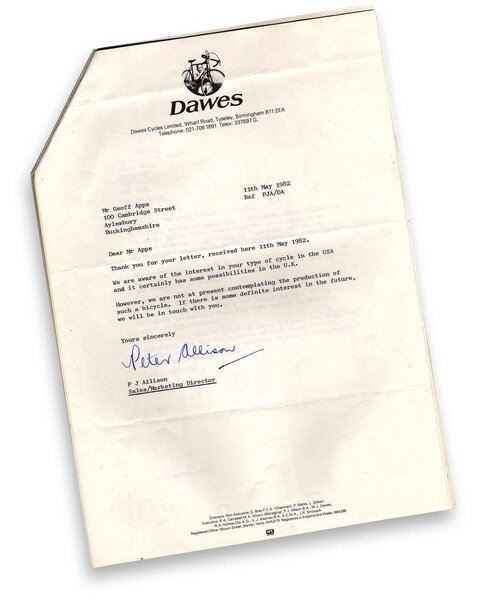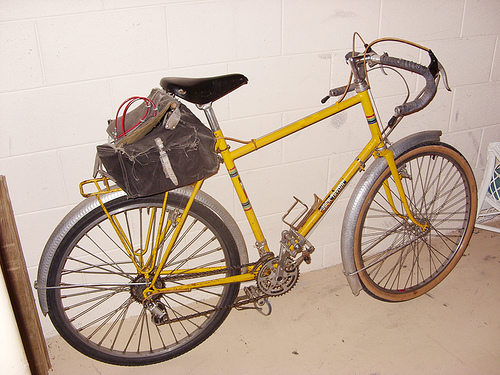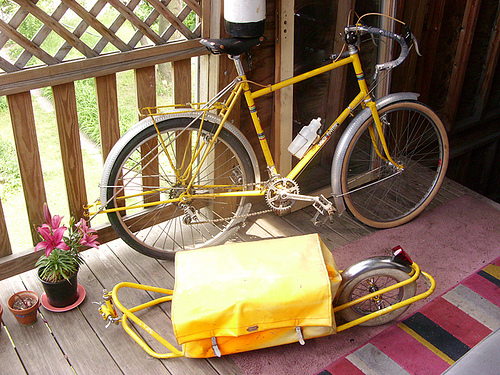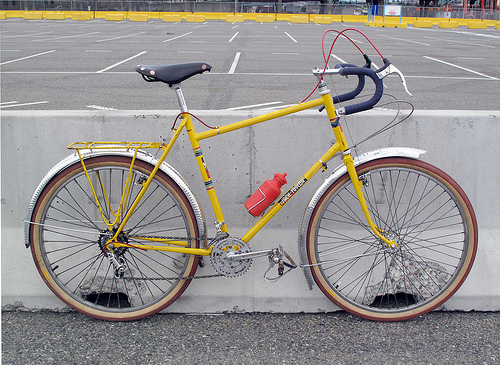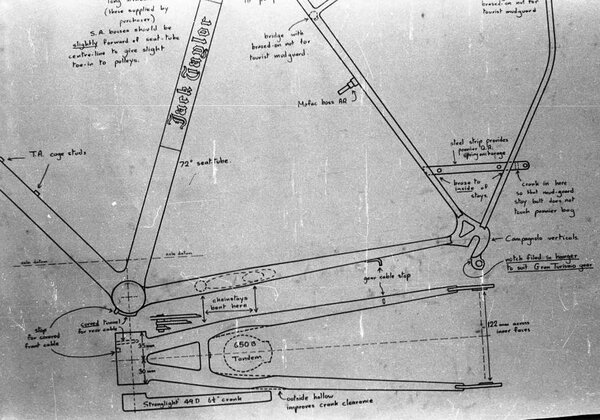You are using an out of date browser. It may not display this or other websites correctly.
You should upgrade or use an alternative browser.
You should upgrade or use an alternative browser.
Jack Taylor 'Rough Stuff' 1979 (1953-1974)
- Thread starter mrkawasaki
- Start date
- Feedback
- View
In design terms, Geoff Apps' bikes were seriously ahead of their time. So much so that the geometry and spec of his 1980 Range-Rider is almost identical to that of a small framed 2005 Giant NRS, minus the suspension of course. That's why I have built some modern Clelands based on the NRS. All you need to do to make the NRS ride like a Cleland is raise and shorten the handlebars and make sure the suspension is preloaded so that the bottom bracket height is raised. The really tricky bit is to turn the NRS into an all weather, low maintainance machines, like the Highpath made Clelands.
1979 RANGE-RIDER' INNOVATIONS
Apps finally completes his first 650B ‘Range Rider’ cross-country prototype around a custom-built frame and all new parts. Features included 2-inch wide low-pressure tyres on narrow 650B rims, a steep frame angles, a sloping top tube, Alpine Derailleur gears, skate plate, hub brakes and full-length mudguards. (Compared to the Marin bikes, Apps’ bikes are capable all-weather bikes, intended to cope as far as possible with mud, snow and ice).
AMERICAN LINKS: Though Apps’ ideas were largely met with indifference in Britain, the mountain bike pioneers in America were much more accepting. Apps read about the Ritchey mountain bike and made contact with Gary Fisher and Charlie Kelly. Knowledge and ideas were exchanged and Apps sent samples of Nokia 700C and 650B Finnish made snow tyres to Fairfax for evaluation. Here, Gary Fisher, speaking about the growing popularity of 29ers, gives his perspective: “We got some tyres from Geoff Apps really early on and we [Fisher and Kelly] said ‘Holy Toledo!’ But the poor supply situation of the larger diameter tyres meant the fledging MTB industry stuck with the smaller wheel size.”
APPS’ POINT OF VIEW: “I sent some of these 700C tyres over to Charlie Kelly and Gary Fisher, who had built a frame in readiness. They loved them; really appreciating the ride they gave compared to 26-inch tyres, and enjoyed the success they had at the races. As far as they were concerned, these 29-inch tyres were the way to go. This was the only tyre of this type and size in the world, there was no other choice. Unfortunately getting a reliable supply was impossible. 26-inch wheels were not absolutely fixed at that time, so, had the supply situation been better, it is quite possible that 700C would be the mountain bike standard now.”
Where Apps’ other ideas influential?
It is impossible to judge to what extent Apps’ many ideas have been influential. Here is Apps on a possible example: “I wrote a letter to Charlie (Charlie Kelly) about how my twist grip gear shifter idea was progressing, and he published it in Fat Tire Flyer! Nothing happened; nobody beat a path to my door. After a decent period, GripShifts appeared on the market. ...Could there possibly be a connection?”
ALSO...The British cycling industry rejected both his designs and the very notion of off-road cycling as a commercial proposition. The 1979 Range-Rider’s frame builder had told Apps that that the stays could not be bent in order to give Apps the short wheelbase and large tyre clearances he wanted. Unlike most early mountain bikes that had curved chain stays, 1984 Dawes’ Ranger also had long unbent chain stays and Apps had previously supplied them drawings of his 1979 Range-Rider, Coincidence?
Carlton Reid, editor of the premier UK trade magazine BikeBiz, gives his view about Apps’ nomination: “...it’s this linkage to the Californian pioneers that needs to be recognised. And recognised by the US Mountain Bike Hall of Fame... as one of the visionaries who helped transform the global market for bicycles?”
1979 RANGE-RIDER' INNOVATIONS
Apps finally completes his first 650B ‘Range Rider’ cross-country prototype around a custom-built frame and all new parts. Features included 2-inch wide low-pressure tyres on narrow 650B rims, a steep frame angles, a sloping top tube, Alpine Derailleur gears, skate plate, hub brakes and full-length mudguards. (Compared to the Marin bikes, Apps’ bikes are capable all-weather bikes, intended to cope as far as possible with mud, snow and ice).
AMERICAN LINKS: Though Apps’ ideas were largely met with indifference in Britain, the mountain bike pioneers in America were much more accepting. Apps read about the Ritchey mountain bike and made contact with Gary Fisher and Charlie Kelly. Knowledge and ideas were exchanged and Apps sent samples of Nokia 700C and 650B Finnish made snow tyres to Fairfax for evaluation. Here, Gary Fisher, speaking about the growing popularity of 29ers, gives his perspective: “We got some tyres from Geoff Apps really early on and we [Fisher and Kelly] said ‘Holy Toledo!’ But the poor supply situation of the larger diameter tyres meant the fledging MTB industry stuck with the smaller wheel size.”
APPS’ POINT OF VIEW: “I sent some of these 700C tyres over to Charlie Kelly and Gary Fisher, who had built a frame in readiness. They loved them; really appreciating the ride they gave compared to 26-inch tyres, and enjoyed the success they had at the races. As far as they were concerned, these 29-inch tyres were the way to go. This was the only tyre of this type and size in the world, there was no other choice. Unfortunately getting a reliable supply was impossible. 26-inch wheels were not absolutely fixed at that time, so, had the supply situation been better, it is quite possible that 700C would be the mountain bike standard now.”
Where Apps’ other ideas influential?
It is impossible to judge to what extent Apps’ many ideas have been influential. Here is Apps on a possible example: “I wrote a letter to Charlie (Charlie Kelly) about how my twist grip gear shifter idea was progressing, and he published it in Fat Tire Flyer! Nothing happened; nobody beat a path to my door. After a decent period, GripShifts appeared on the market. ...Could there possibly be a connection?”
ALSO...The British cycling industry rejected both his designs and the very notion of off-road cycling as a commercial proposition. The 1979 Range-Rider’s frame builder had told Apps that that the stays could not be bent in order to give Apps the short wheelbase and large tyre clearances he wanted. Unlike most early mountain bikes that had curved chain stays, 1984 Dawes’ Ranger also had long unbent chain stays and Apps had previously supplied them drawings of his 1979 Range-Rider, Coincidence?
Carlton Reid, editor of the premier UK trade magazine BikeBiz, gives his view about Apps’ nomination: “...it’s this linkage to the Californian pioneers that needs to be recognised. And recognised by the US Mountain Bike Hall of Fame... as one of the visionaries who helped transform the global market for bicycles?”
- Feedback
- View
Follow the link below if you are interested in the development of Modern "Cleland Cross Country Cycle" designs.
http://www.retrobike.co.uk/forum/viewto ... ht=cleland
http://www.retrobike.co.uk/forum/viewto ... ht=cleland
- Feedback
- View
GrahamJohnWallace":2pjv80ig said:The British cycling industry rejected both his designs and the very notion of off-road cycling as a commercial proposition. The 1979 Range-Rider’s frame builder had told Apps that that the stays could not be bent in order to give Apps the short wheelbase and large tyre clearances he wanted. Unlike most early mountain bikes that had curved chain stays, 1984 Dawes’ Ranger also had long unbent chain stays and Apps had previously supplied them drawings of his 1979 Range-Rider, Coincidence?
Attachments
- Feedback
- View
'bump'
- Feedback
- View
The circa 1979 Rough stuff bike rides on.
I found this tread on MTBR.
http://forums.mtbr.com/showthread.php?t=682981
And this from its owner on Flickr...
http://www.flickr.com/photos/77646587@N ... 660374680/
I found this tread on MTBR.
http://forums.mtbr.com/showthread.php?t=682981
And this from its owner on Flickr...
http://www.flickr.com/photos/77646587@N ... 660374680/
Attachments
- Feedback
- View
A 'bump' and after re-reading the whole thread, I would like the opinions of others on this as there are some similarities going on - short wheelbase, hub brake specific,slightly higher than standard BB - does it ring any bells with anyone?:
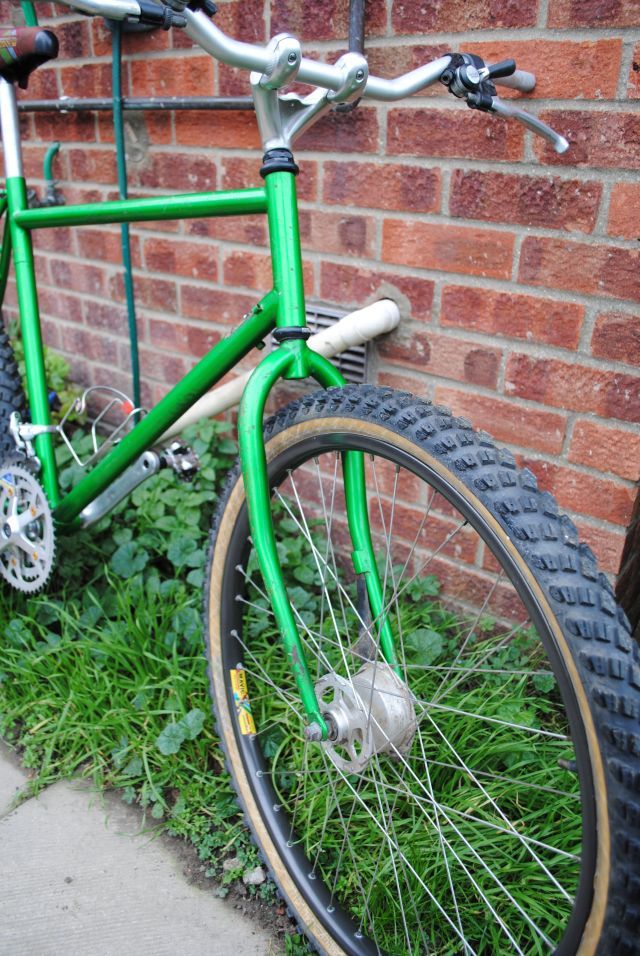
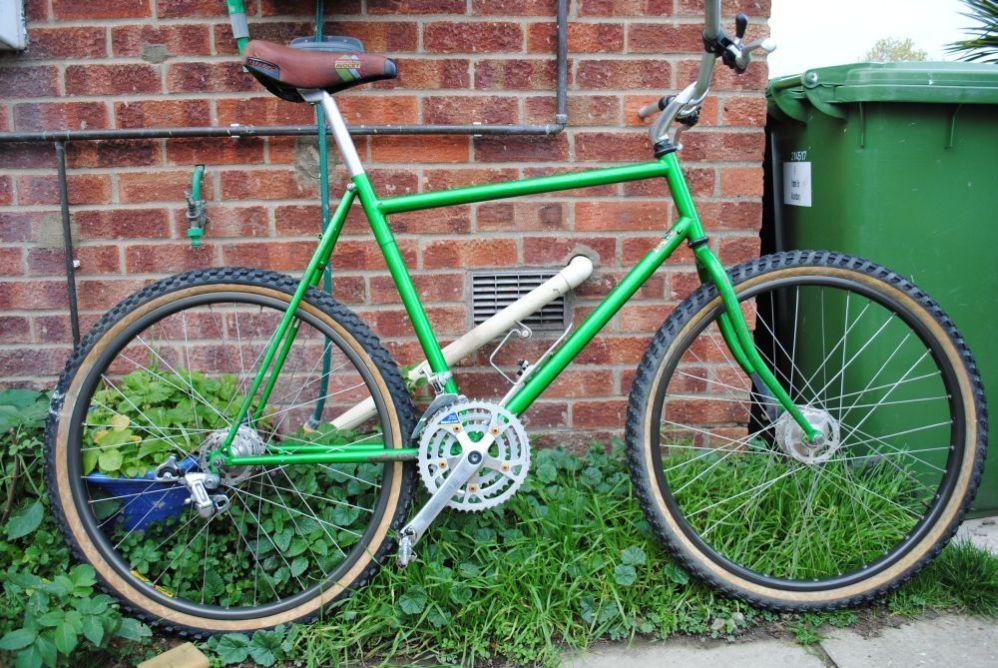
full thread here: http://www.retrobike.co.uk/forum/viewtopic.php?t=122960


full thread here: http://www.retrobike.co.uk/forum/viewtopic.php?t=122960
- Feedback
- View
- Feedback
- View
bump!
Similar threads
- Replies
- 30
- Views
- 9K
Latest posts
-
-
-
For Sale Araya RM25 1985 Suntour XCD 6000 hubs vg condition Mullet style
- Latest: 27motorhead
-
